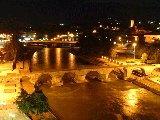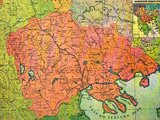| |
Geography
Macedonia has a total area of 25,333 km2 (9,781 sq mi). It has some 748 km (465 mi) of boundaries, shared with Serbia (62 km or 39 mi), Kosovo (159 km or 99 mi), Bulgaria (148 km or 92 mi), Greece (228 km or 142 mi), and Albania (151 km or 94 mi). It is a transit way for shipment of goods from Greece, through the Balkans, towards Eastern, Western and Central Europe and through Bulgaria to the East. It is part of a larger region also known as Macedonia, which also includes Aegean Macedonia (a region of northern Greece) and Pirin Macedonia (in southwestern Bulgaria).

Topography
Macedonia is a landlocked country that is geographically clearly defined by a central valley formed by the Vardar river and framed along its borders by mountain ranges. The terrain is mostly rugged, located between the Shar Mountains and Osogovo, which frame the valley of the Vardar river. Three large lakes - Lake Ohrid, Lake Prespa and Dojran Lake - lie on the southern borders, bisected by the frontiers with Albania and Greece. Ohrid is considered to be one of the oldest lakes and biotopes in the world. The region is seismically active and has been the site of destructive earthquakes in the past, most recently in 1963 when Skopje was heavily damaged by a major earthquake, killing over 1,000.
Macedonia also has scenic mountains. They belong to two different mountain ranges: the first is the Shar Mountains that continues to the West Vardar/Pelagonia group of mountains (Baba Mountain, Nidze, Kozhuf and Jakupica), also known as the Dinaric range. The second range is the Osogovo–Belasica mountain chain, also known as the Rhodope range. The mountains belonging to the Shar Mountains and the West Vardar/Pelagonia range are younger and higher than the older mountains that are part of the Osogovo-Belasica mountain group. The five highest mountains in Macedonia are: Mount Korab (2,764 m or 9,396 ft), Shar Mountains (2,747 m or 9,012 ft), Baba Mountain (2,601 m or 8,533 ft), Jakupica (2,540 m or 8,333 ft) and Nidze (2,521 m or 8,271 ft).
Climate
Macedonia has a transitional climate from Mediterranean to continental. The summers are hot and dry and the winters are moderately cold. Average annual precipitation varies from 1,700 mm (66.9 in) in the western mountainous area to 500 mm (19.7 in) in the eastern area. There are three main climatic zones in the country: temperate Mediterranean, mountainous and mildly Continental. The warmest regions are Demir Kapija and Gevgelija, where the temperature in July and August frequently exceeds 40 °C (104 °F). The mountainous climate is present in the mountainous regions of the country and it is characterised by long and snowy winters and short and cold summers. The spring is colder than the fall. The majority of Macedonia has a moderate continental climate with warm and dry summers and relatively cold and wet winters.

Regions, Municipalities and Cities
Macedonia's statistical regions exist solely for legal and statistical purposes. The regions are: Skopje, Pelagonia, Polog, Eastern, Southeastern, Northeastern, Southwestern and Vardar.
In August 2004, Macedonia's local government was reorganised into 84 municipalities (општини, opshtini), 10 of which comprise Greater Skopje.
Politics
Macedonia is a parliamentary democracy with an executive government composed of a coalition of parties from the unicameral legislature (Собрание, Sobranie) and an independent judicial branch with a constitutional court. The Assembly is made up of 120 seats and the members are elected every four years. The role of the President of the Republic is mostly ceremonial, with the real power resting in the hands of the President of the Government. The President is the commander-in-chief of the state armed forces and a president of the state Security Council. The President is elected every five years and he or she can be elected twice at most.
With the passage of a new law and elections held in 2005, local government functions are divided between 78 municipalities (општини, opshtini). The capital, Skopje, is governed as a group of ten municipalities collectively referred to as the "City of Skopje". Municipalities in Macedonia are units of local self-government.
Judiciary power is exercised by courts, with the court system being headed by the Judicial Supreme Court, Constitutional Court and the Republican Judicial Council. The assembly appoints the judges.
The Macedonian Armed Forces comprise the army, air force and Special Forces. The government's national defence policy aims to guarantee the preservation of the independence and sovereignty of the state, the integrity of its land area and airspace and its constitutional order. Its main goals remain the development and maintenance of a credible capability to defend the nation's vital interests and development of the Armed Forces in a way that ensures their interoperability with the armed forces of NATO and the European Union member states and their capability to participate in the full range of NATO missions.

Religion
Christians are a majority, with 64.7% of the population belonging to the Macedonian branch of Eastern Orthodoxy, while various Christian denominations occupy 0.37% of the population. Muslims comprise 33.3% of the population. Most Muslims are Albanian, Turkish, or Roma, although some are Macedonian Muslims. The remaining 1.63% is recorded as "unspecified" in the 2002 national census. Altogether, there are more than 1200 churches and 400 mosques in the country.
The Macedonian Orthodox Church has jurisdiction over 10 provinces (seven in the country and three abroad), has 10 bishops and about 350 priests.
The Macedonian Byzantine Catholic Church has approximately 11,000 adherents in Macedonia. There is a small Protestant community. The Macedonian Jewish community, which numbered some 7,200 people.
Languages
The official and most widely spoken language is Macedonian, which belongs to the Eastern branch of the South Slavic language group. Although it is the only language explicitly designated as an official national language in the constitution, in municipalities where at least 20% of the population is part of another ethnic minority, those individual languages are used for official purposes in local government, alongside Macedonian.
A wide variety of languages are spoken in Macedonia, reflecting its ethnic diversity. Besides the official national language Macedonian, minority languages with substantial numbers of speakers are: Albanian, Romani, Turkish, Serbian/Bosnian and Aromanian (including Megleno-Romanian).
History
Located in the center of the Southern Balkans, north of Greece, and west of Thrace, the history of Macedonia tells how the Macedonians were a distinct nation, ethnically, linguistically, and culturally different from their neighbors. The name "Macedonia" is the oldest existing name of a country on the continent of Europe. The history of Macedonia gives us an over view from the time when that old European civilization flourished in Macedonia between 7000 and 3500 BC to the time of the Macedonian partition till they got their independence.
Ancient history of the territory
In antiquity, most of the territory that is now the Republic of Macedonia was included in the kingdom of Paeonia, which was populated by the Paeonians, a people of Thracian origins, but also parts of ancient Illyria and Dardania, inhabited by various Illyrian peoples, and Lyncestis and Pelagonia populated by Molossian tribes. None of these had fixed boundaries; they were sometimes subject to the Kings of Macedon, and sometimes broke away. In 336 BC Philip II of Macedon conquered Upper Macedonia, including its northern part and southern Paeonia, which both now lie within the Republic of Macedonia. Philip's son Alexander the Great conquered the remainder of the region, reaching as far north as the Danube, and incorporated it in his empire.
Medieval period
In the late 6th century AD, the south Slavic tribes settled in the territory of the present-day Republic of Macedonia which was under the Byzantine control. They were known as the 'Sklavines' by the Byzantine Greek historians. The Slavic tribes absorbed the preexisting Greek, Latin, Illyrian and Thracian-speaking inhabitants. By the 9th century through the evangelizing work of the Saints Cyril and Methodius and their disciples, the people of the territory converted to Christianity.
The 7th century saw the capture of over 110,000 Slavs by Justinian II and his troops, transferring them to Cappadocia. By 836/837 there were no remaining Byzantine records of the 'Sklavines', with them being assimilated into the First Bulgarian Empire. Full control was reassumed by the Byzantines of the Balkans by the early 11th century, but the birth of the Second Bulgarian Empire came with the decline of the Byzantine by the late 12th century. Political difficulties brought the empire back in the hands of the Byzantine control but in the 14th century it became part of the Serbian Empire. A few decades later though it came under the Ottoman control under whose rule it was to remain for five centuries.
For the next 500 years the region remained a part of the Ottoman Empire gaining a substantial Turkish minority, especially in the religious sense of Muslim. The uprising and the forming of the Krushevo Republic are considered the corner-stone and forerunners to the ultimate establishment of the Republic of Macedonia.

Kingdoms of Serbia and Yugoslavia
This phase of Macedonian history is referred to as the 'Partitioned Macedonia', with the wider region of Macedonia getting divided between the Greece, Bulgaria and Serbia following the two Balkan wars of 1912 and 1913 and the dissolution of the Ottoman Empire. The territory of the present-day Republic of Macedonia had no administrative autonomy and was then named 'Juzhna Srbija' (Southern Serbia).
By the end of the World War I, Serbia became part of the Kingdom of Serbs, Croats and Slovenes. The Kingdom was officially renamed the Kingdom of Yugoslavia in 1929.
Yugoslav Macedonia in World War II
During World War II, Yugoslavia was occupied by the Axis Powers from 1941 to 1945. Macedonia (the Vardar Banovina) was divided between Bulgaria and Italian-occupied Albania in 1941. Many who opposed the regime of the occupying powers joined the Communist resistance movement of Josip Broz Tito. In 1944 the Anti-Fascist Assembly for the National Liberation of Macedonia (ASNOM) proclaimed the People's Republic of Macedonia as part of the People's Federal Republic of Yugoslavia. ASNOM remained an acting government until the end of the war.
The new republic became one of the six republics of the Yugoslav federation. Following the federation's renaming as the Socialist Federal Republic of Yugoslavia in 1963, the People's Republic of Macedonia was likewise renamed, becoming the Socialist Republic of Macedonia. It dropped the "Socialist" from its name in 1991 when it peacefully seceded from Yugoslavia.
Independence
On 8th September, 1991 a referendum was held establishing its independence from Yugoslavia, under the name of the Republic of Macedonia.
Macedonia remained at peace through the Yugoslav wars of the early 1990s. A few very minor changes to its border with Yugoslavia were agreed upon to resolve problems with the demarcation line between the two countries. However, it was seriously destabilised by the Kosovo War in 1999, when an estimated 360,000 ethnic Albanian refugees from Kosovo took refuge in the country. Although they departed shortly after the war, soon after, Albanian radicals on both sides of the border took up arms in pursuit of autonomy or independence for the Albanian-populated areas of Macedonia.
A civil war was fought between government and ethnic Albanian insurgents, mostly in the north and west of the country, between March and June 2001. The war ended with the intervention of a NATO ceasefire monitoring force. Under the terms of the Ohrid Agreement, the government agreed to devolve greater political power and cultural recognition to the Albanian minority. The Albanian side agreed to abandon separatist demands and to fully recognise all Macedonian institutions. In addition, according to this accord, the NLA were to disarm and hand over their weapons to a NATO force. |
|
